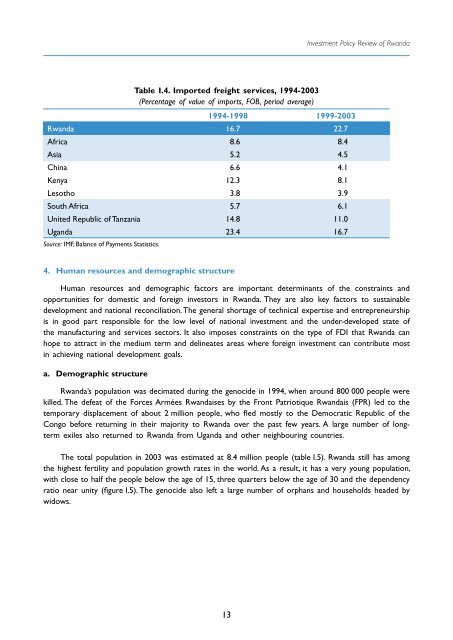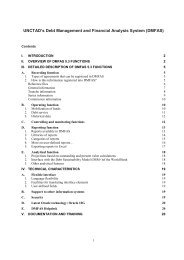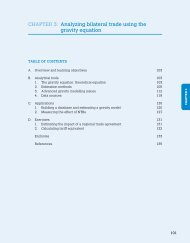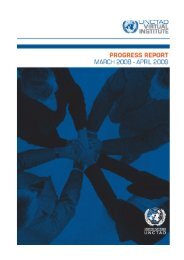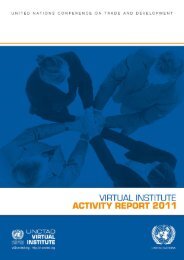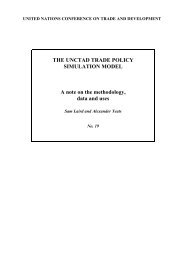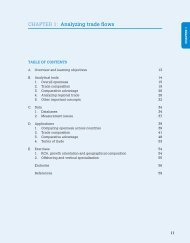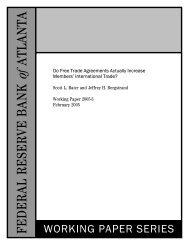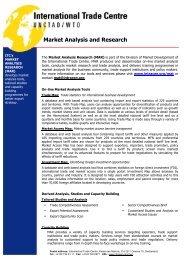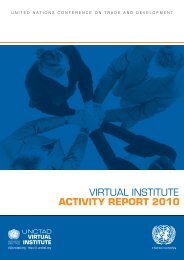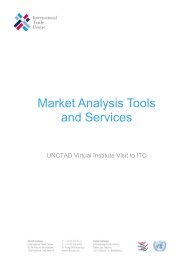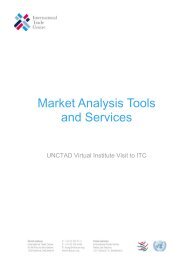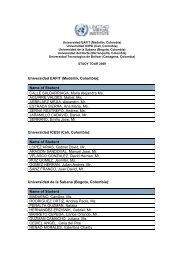Investment Policy Review - Rwanda - UNCTAD Virtual Institute
Investment Policy Review - Rwanda - UNCTAD Virtual Institute
Investment Policy Review - Rwanda - UNCTAD Virtual Institute
Create successful ePaper yourself
Turn your PDF publications into a flip-book with our unique Google optimized e-Paper software.
<strong>Investment</strong> <strong>Policy</strong> <strong>Review</strong> of <strong>Rwanda</strong><br />
Table I.4. Imported freight services, 1994-2003<br />
(Percentage of value of imports, FOB, period average)<br />
1994-1998 1999-2003<br />
<strong>Rwanda</strong> 16.7 22.7<br />
Africa 8.6 8.4<br />
Asia 5.2 4.5<br />
China 6.6 4.1<br />
Kenya 12.3 8.1<br />
Lesotho 3.8 3.9<br />
South Africa 5.7 6.1<br />
United Republic of Tanzania 14.8 11.0<br />
Uganda 23.4 16.7<br />
Source: IMF, Balance of Payments Statistics.<br />
4. Human resources and demographic structure<br />
Human resources and demographic factors are important determinants of the constraints and<br />
opportunities for domestic and foreign investors in <strong>Rwanda</strong>. They are also key factors to sustainable<br />
development and national reconciliation. The general shortage of technical expertise and entrepreneurship<br />
is in good part responsible for the low level of national investment and the under-developed state of<br />
the manufacturing and services sectors. It also imposes constraints on the type of FDI that <strong>Rwanda</strong> can<br />
hope to attract in the medium term and delineates areas where foreign investment can contribute most<br />
in achieving national development goals.<br />
a. Demographic structure<br />
<strong>Rwanda</strong>’s population was decimated during the genocide in 1994, when around 800 000 people were<br />
killed. The defeat of the Forces Armées <strong>Rwanda</strong>ises by the Front Patriotique <strong>Rwanda</strong>is (FPR) led to the<br />
temporary displacement of about 2 million people, who fled mostly to the Democratic Republic of the<br />
Congo before returning in their majority to <strong>Rwanda</strong> over the past few years. A large number of longterm<br />
exiles also returned to <strong>Rwanda</strong> from Uganda and other neighbouring countries.<br />
The total population in 2003 was estimated at 8.4 million people (table I.5). <strong>Rwanda</strong> still has among<br />
the highest fertility and population growth rates in the world. As a result, it has a very young population,<br />
with close to half the people below the age of 15, three quarters below the age of 30 and the dependency<br />
ratio near unity (figure I.5). The genocide also left a large number of orphans and households headed by<br />
widows.<br />
13


